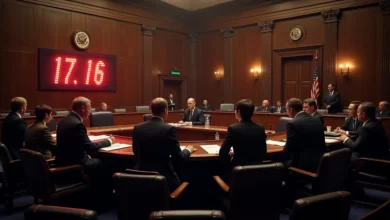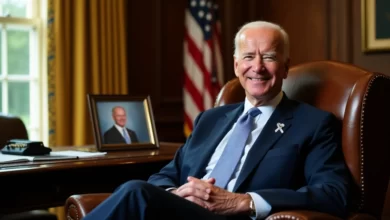Why Netanyahu’s Meeting With Trump

Why Netanyahu’s Meeting With Trump Shows Surprising Policy Splits in 2025
Netanyahu’s recent Washington visit showed a surprising change in what many thought was an unbreakable alliance. The United States maintains its $4 billion yearly military aid, yet clear policy differences surfaced during this last-minute meeting.
Netanyahu wanted backing for his tough position on Iran and relief from America’s 17% tariffs on Israeli goods. Trump’s responses turned out unexpectedly balanced. Trump pushed for a sensible approach toward Turkey and showed eagerness to resolve the Gaza conflict. These responses point to growing complexities in America’s relationship with Israel.
The emerging policy differences tell a bigger story about Middle East dynamics and the future of U.S.-Israel strategic collaboration. A closer look reveals how internal pressures and regional power changes are reshaping this vital partnership.
The Unexpected Policy Rifts Between Netanyahu and Trump
President Trump’s meeting with Prime Minister Netanyahu revealed policy differences that few saw coming from this historically close alliance. Their contrasting views on three vital issues have altered the map of US-Israel cooperation.
Iran nuclear talks vs. military pressure
The deepest split came over Iran’s nuclear program. Netanyahu has always supported military action against Iran’s nuclear facilities. He played a key role in Trump’s 2018 exit from Obama’s nuclear agreement.
Trump caught Netanyahu off guard by announcing direct US-Iran nuclear talks set for Saturday in Oman. “We’re dealing with them directly and maybe a deal is going to be made,” Trump declared. He warned Iran would face “great danger” if talks failed.
Netanyahu’s response was cautious. He said he would welcome an agreement similar to Libya’s that required full dismantlement of Iran’s nuclear program. His muted response shows his belief that only military pressure can stop Iran’s nuclear goals.
Tariff tensions despite historical alliance
A surprising rift opened up over Trump’s new tariff policy. Israel removed all its remaining tariffs on US imports, but Netanyahu couldn’t get the same treatment in return.
Trump’s response about cutting the 17% tariff on Israeli goods was direct: “maybe not.” He pointed to the $4 billion in yearly US military aid to Israel. This stance stood out because:
- These tariffs hit Israeli diamonds, machinery, electrical and medical equipment hardest
- The US and Israel’s free trade agreement dates back to 1985
- Israel’s Manufacturers Association projects losses around $2.3 billion
Divergent views on Turkey’s role in Syria
The biggest surprise came when Trump publicly disagreed with Netanyahu about Turkey’s growing presence in Syria. Netanyahu warned that “Turkish bases in Syria would be a ‘danger to Israel'”. He looked to America to back him against this threat.
Trump took a different path. He praised Turkish President Erdogan as “a tough guy” and “very smart“, while giving him credit for effectively “taking over Syria”. Trump positioned himself as a mediator and told Netanyahu he “has to be reasonable” in dealing with Turkey.
This public split shows a basic shift in regional priorities. Trump seems to value his relationship with Erdogan more than Netanyahu’s worries about Turkish influence near Israel’s northern border.
How Middle East Power Dynamics Are Reshaping US-Israel Relations
The power balance in the Middle East now shapes how Netanyahu and Trump interact with each other, creating new priorities for both leaders. Three most important regional developments have reshaped their strategic thinking.
Saudi Arabia’s growing regional influence
Saudi Arabia has overtaken Egypt as the undisputed leader of the Arab world. The kingdom wields substantial soft power and commands huge oil-generated resources. Iran and Sunni Islamist political opposition remain the only real threats to the kingdom. This situation has arranged Saudi Arabia’s interests with Israel’s for the first time in history.
Crown Prince Mohammed bin Salman guides Saudi Arabia’s strategic repositioning. The kingdom maintains that Palestinian statehood must come before any normalization with Israel. Yet Saudi Arabia allowed Israeli flights over its territory and let Bahrain recognize Israel in 2020.
Saudi Arabia has become a crucial mediator between Tehran and Washington. The kingdom’s warming relations with Iran—shown by Riyadh’s condemnation of Israel’s attack on Iran in October 2024—offer maybe even Iran’s only bright spot in its weakening regional position.
Iran’s strategic calculations after Trump’s return
Iran stands more vulnerable than ever before. Its once-powerful “axis of resistance” has crumbled—Hamas and Hezbollah have weakened severely from Israeli strikes, and Assad’s fall removed a crucial geographical connection. Trump’s return to “maximum pressure” sanctions limits Tehran’s options further.
Notwithstanding that, Iran has sped up uranium enrichment to near-weapons grade. Monthly production at Fordow jumped from 4.7 to 34 kilograms —analysts see this as building negotiating power. Tehran has shown openness to indirect nuclear talks, accepting its reduced strategic position.
The Islamic Republic must now choose between keeping its expensive “forward defense” strategy or focusing on domestic needs. This decision comes as internal debates grow about a nuclear deterrent’s security value.
Turkey’s expanding footprint in Syria
Turkey has replaced Russia as Syria’s main power player since Assad’s fall. Ankara now controls about 8,000 square kilometers from Idlib to Ras al-Ayn. Turkish troops sit dangerously close to Israeli territory.
Netanyahu has warned Turkey against establishing presence on Israel’s Syrian border. He called it a “red line.” Recent Israeli airstrikes hit bases Turkey wanted to use for deployment. These actions show serious concerns about Erdogan’s goals.
Turkish expansion creates complex choices for Netanyahu and Trump. The Israeli prime minister sees Ankara’s presence as “even more dangerous than the Iranian threat”. Trump positions himself as a mediator and urges Netanyahu to be “reasonable” with Turkey.
Strategic Calculations Behind Netanyahu’s Washington Visit
Netanyahu’s hastily arranged White House visit in April 2025 revealed more about Israeli politics than international diplomacy. A complex web of calculations shaped the timing, domestic pressures, and expectations of the meeting. The prime minister’s precarious position became evident through these developments.
Timing of the visit amid Gaza conflict
Netanyahu went to Washington at a crucial moment after Israel unilaterally restarted the Gaza war in March, which ended a Trump-endorsed ceasefire. He made this decision despite Trump’s previous support for the truce that had secured the release of 33 hostages, including 25 living. The visit’s official purpose centered on Trump’s new 17% tariff regime, but regional tensions drove its urgency.
The prime minister reached the U.S. while Israeli forces bombarded Gaza, killing over 1,000 Palestinians in just three weeks. This timing helped Netanyahu present his resumed offensive as a security measure rather than a political move.
Netanyahu’s domestic political pressures
Political survival calculations drove the Washington visit. The war’s restart strengthened Netanyahu’s coalition—Religious Zionism stayed loyal, and Otzma Yehudit returned to government. His Knesset majority grew to 68 seats. This move neutralized the budget deadline threat that could have triggered elections by March 31.
Netanyahu faced growing domestic opposition. Most Israelis wanted the government to end the war or honor the ceasefire agreement, according to polls. The prime minister needed Trump’s public support to counter resignation calls amid corruption charges that risked imprisonment if he left office.
The gamble on Trump’s unconditional support
Netanyahu’s strategy depended on Trump’s continued backing—a calculation that proved risky. Trump had previously told the prime minister “Do what you have to do” regarding Gaza , but the Washington meeting showed limits to this support.
The gamble worked in part: Trump praised Netanyahu as “a great leader” and avoided criticizing the judicial overhaul that threatened Israeli democracy. Yet Trump showed independence on key policy issues, which suggested their relationship was more complex than Netanyahu had predicted.
The visit represented Netanyahu’s high-stakes bet that his personal connection with Trump would provide diplomatic cover for his controversial domestic agenda—maybe his most pressing concern as calls for his removal grew louder.
Global Implications of the Netanyahu-Trump Policy Splits
Policy differences between Netanyahu and Trump reach way beyond their bilateral relationship and create waves across global diplomacy, economics, and security. These unexpected divisions reshape international strategies and alliances when Middle East stability hangs in the balance.
Impact on international efforts to contain Iran
Trump’s diplomatic outreach clashes with Netanyahu’s military focus, making global coordination on Iran more difficult. Trump wants direct nuclear talks, which points to a possible return to multilateral containment strategies that Israel never supported. European allies don’t deal very well with this split as they try to keep parts of the JCPOA framework alive since 2018.
Netanyahu publicly claims that “the only solution to stop Iran’s rapidly advancing nuclear program is military intervention” , which goes against Trump’s diplomatic plans. Their disagreement weakens the unified front needed to pressure Tehran. Iran might use these divisions to its advantage during upcoming negotiations in Oman.
Previous international sanctions cost Iran’s economy 15-20% of GDP and $160 billion in lost oil revenue . These numbers could change based on which approach wins out. The military deterrent also faces uncertainty – U.S. forces helped Israel stop two separate Iranian missile attacks in 2024.
Economic consequences of US-Israel trade tensions
The 17% tariff on Israeli goods will shake up global trade patterns right away. Israeli exports to the U.S. reached $37.20 billion in 2024 ($14.30 billion in goods and $22.90 billion in services). This means potential yearly costs could hit $2.90 billion.
Key affected sectors include:
- Diamonds and precious stones
- Electrical machinery and systems
- Medical and optical equipment
- Pharmaceuticals
Bank Hapoalim’s chief markets strategist warns of bigger problems ahead: “even if Israel signs a new trade agreement with the U.S. this week that substantially moderates the extent of the tariffs… local economic growth will be hit as the global trade war worsens”. Economists have already reduced Israel’s GDP growth forecasts from 4% to 3.5%.
Moving alliances in the Middle East
Saudi Arabia’s role as a potential arbitrator between Israel and the region becomes trickier with these divisions. The kingdom told the U.S. clearly that its airspace is off-limits for operations against Iran. This limits military options if diplomacy fails.
Turkey benefits from the Netanyahu-Trump split, with Trump praising Erdogan for “taking over Syria” despite Israel’s security worries. This creates new security considerations for Egypt and Jordan.
The policy differences might derail Trump’s plans to broker Saudi-Israeli normalization. Saudi Crown Prince Mohammed bin Salman could push for a “grand bargain” that addresses Gaza, Lebanon, and Syria issues all at once—exactly where Netanyahu and Trump disagree now.
Trump show a major
The unexpected policy differences between Netanyahu and Trump show a major change in US-Israel relations. Their clashing views on Iran, trade tariffs, and Turkey’s role point to deeper changes in Middle East dynamics that both leaders must address.
Netanyahu’s trip to Washington exposed how personal relationships don’t always translate to diplomatic success. Trump’s public praise couldn’t mask his cautious stance on key issues, which showed a clear move away from total support. The Middle East’s power structure continues to change as Saudi Arabia gains influence, Iran adjusts its strategy, and Turkey expands its reach.
These policy disagreements affect much more than just the two countries’ relationship. Trade tensions could hurt Israel’s economic growth, while different approaches to Iran make it harder to contain their influence globally. Both nations now have to think hard about their strategic priorities.
The future of Middle East alliances might look very different because of these policy splits. The US-Israel bond stays strong, but their different ways of handling regional challenges reveal a more complicated partnership. This development means both sides must carefully balance maintaining stability while looking after their own interests.



